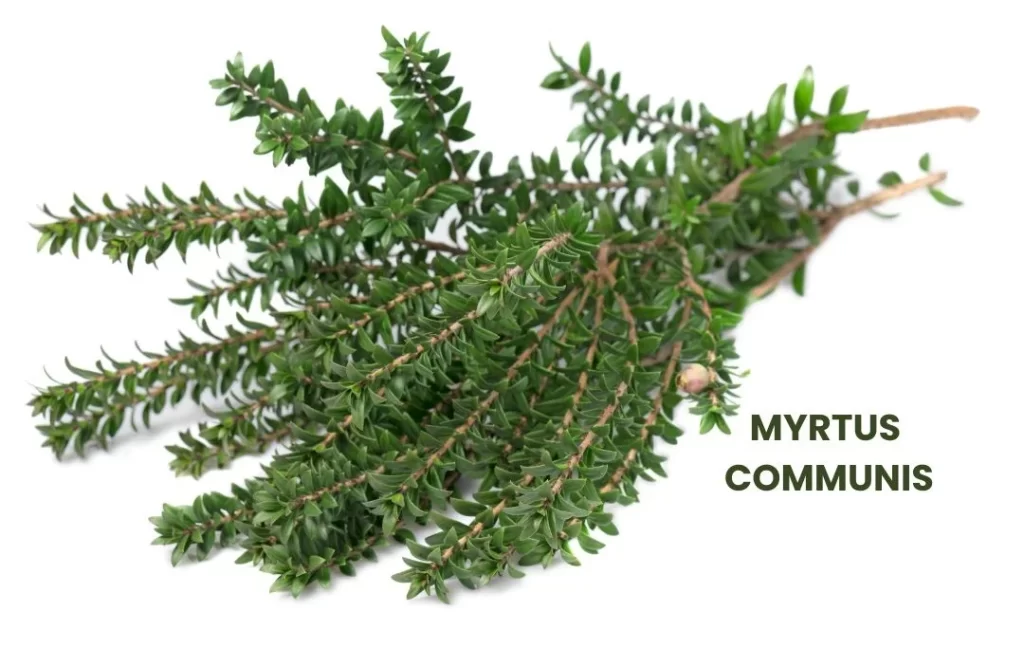Myrtus Communis, commonly known as Myrtle, is a medicinal plant renowned for its active ingredient Myrtol, which exhibits potent antiseptic properties.
It has been traditionally used to alleviate chest pains associated with conditions like consumption (tuberculosis), and it serves as a nerve sedative and mucous membrane stimulant beneficial for respiratory and urinary tract ailments.

SOURCE INFORMATION
Scientific Classification
- Kingdom: Plantae
- Clade: Angiosperms
- Order: Myrtales
- Family: Myrtaceae
- Genus: Myrtus
- Species: Myrtus communis
Origin and Historical Use
- Myrtus communis is native to the Mediterranean region and has a rich history of medicinal use dating back to ancient times.
- It has been valued for its aromatic properties and therapeutic benefits in treating respiratory and urinary conditions.
DRUG PATHOGENESIS
- Myrtus communis acts as a nerve sedative and mucous membrane stimulant.
- It is indicated for chest pains, especially in consumptive disorders like incipient phthisis (early tuberculosis).
- Effective in bronchitis, cystitis, and pyelitis due to its antiseptic properties.
KEY CHARACTERISTICS
CHEST SYMPTOMS
- Stitching pain in the left breast, extending through to the shoulder-blade.
- Dry, hollow cough with tickling sensation in the chest, worsened in the morning.
- Burning sensation in the left chest.
MODALITIES
- Symptoms worsen in the morning.
- Stitching pains exacerbated by movement or deep breathing.
WHAT ARE MODALITIES IN HOMOEOPATHY?
RELATIONSHIP WITH OTHER DRUGS
Myrtus Communis vs. Myrtus Chekan
MYRTUS COMMUNIS
Indications
- Used for chest pains, especially in consumptive disorders like incipient phthisis (early tuberculosis).
- Effective in bronchitis with dry, hollow cough and burning sensation in the left chest.
- Acts as a nerve sedative and mucous membrane stimulant.
MYRTUS CHEKAN
Indications
- Specifically indicated for chronic bronchitis.
- Symptoms include dense, yellowish sputum that is difficult to detach.
- Copious expectoration that keeps the patient distressed and continually coughing.
Comparison
- Both remedies belong to the Myrtus genus and share similarities in their therapeutic application for respiratory conditions.
- However, they differ in specific symptomatology and indications:
MYRTUS COMMUNIS
- Addresses general chest pains associated with early tuberculosis and acts as a mucous membrane stimulant.
- Suitable for dry, hollow coughs with a burning sensation in the chest, worsened in the morning.
MYRTUS CHEKAN
- Targeted specifically at chronic bronchitis.
- Symptoms include dense, yellowish sputum that is challenging to expectorate.
- Patients experience continuous distress due to persistent coughing and copious expectoration.
Clinical Differentiation
- Myrtus Communis is broader in its application, focusing on chest pains and early consumptive disorders, with a dry cough and burning chest sensations predominating.
- Myrtus Chekan, on the other hand, is more specialized for chronic bronchitis characterized by stubborn, yellowish sputum and ongoing, distressing coughing episodes.
Prescription Considerations
Choosing between these remedies depends on the specific presentation of the patient’s respiratory symptoms:
- Myrtus Communis for general chest pains and early-stage tuberculosis with dry, irritating cough.
- Myrtus Chekan for chronic bronchitis with difficult expectoration and persistent, distressing coughing fits.
DOSE
- Typically prescribed in the third potency.
Frequently Asked Questions (FAQs)
What are the main uses of Myrtus Communis?
- It is used primarily for chest pains associated with consumptive disorders, dry cough with chest tickling, and conditions like bronchitis and cystitis.
How does Myrtus Communis affect the respiratory system?
- It acts as a mucous membrane stimulant and antiseptic, providing relief in cases of chronic bronchitis and incipient phthisis.
Meaning of Difficult Words
- Myrtol: Active antiseptic compound found in Myrtus Communis.
- Phthisis: A now outdated term for tuberculosis, especially pulmonary tuberculosis.
This comprehensive drug picture of Myrtus Communis highlights its therapeutic uses, characteristics, and relationship with other remedies, providing valuable insights for practitioners of homeopathy and individuals seeking natural remedies for respiratory and urinary tract ailments.
